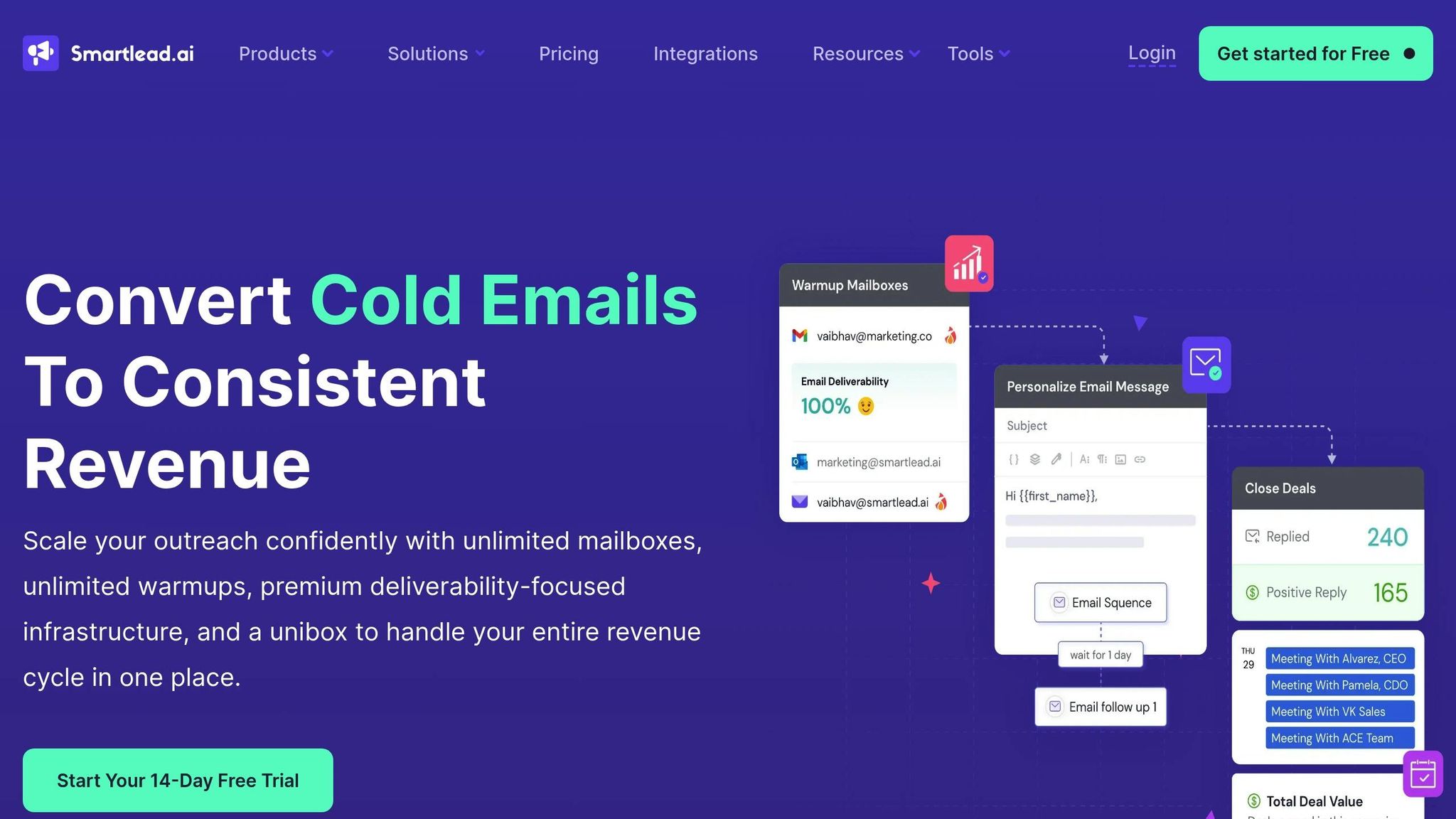Want to maximize your email marketing ROI? High-volume email automation can generate up to $36 for every $1 spent, with automated emails driving 37% of sales despite making up just 2% of email volume. Here’s what you need to know:
- Personalization Works: AI-driven emails boost click-through rates by 41%.
- Technical Setup Matters: Dedicated servers, IPs, and security protocols like SPF/DKIM/DMARC improve deliverability by 10%.
- Automation Delivers: Workflows like abandoned cart reminders and welcome emails generate 320% more revenue.
- Compliance Saves Money: Avoid fines of up to $53,088 per email by following laws like CAN-SPAM and GDPR.
- Smart Budgeting: Platforms start at $299/month, with costs scaling based on contact size and features.
Quick Tip: Clean your lists regularly, segment audiences, and use behavior tracking to improve engagement and reduce bounce rates. Ready to take your campaigns to the next level? Let’s dive in.
How To Automate 1 MILLION Emails Per Month With Smartlead | Harry Latos

Technical Setup for Mass Email Campaigns
Getting the technical setup right can make a big difference in your email campaigns. In fact, with proper authentication protocols in place, deliverability can improve by up to 10%.
Server and System Requirements
If you're running large-scale email campaigns, dedicated email servers are non-negotiable. They ensure your emails are sent efficiently without overloading your system. To keep things running smoothly, load balancing across multiple servers is key. This helps avoid bottlenecks and ensures consistent delivery. Here’s a breakdown of the key infrastructure components:
| Component | Requirement | Impact |
|---|---|---|
| Server Type | Dedicated bulk email servers | Maintains stable performance |
| IP Configuration | Multiple dedicated IPs | Improves deliverability |
| Queue Management | Email throttling system | Controls delivery rates |
| Performance Monitoring | Real-time tracking tools | Detects issues immediately |
Take this example: In May 2025, Smartlead user Matt Lucero saw his email bounce rate drop from 3.89% to just 0.45%. How? By switching to dedicated SmartServers. Once your server setup is optimized, the next step is to focus on email security.
Email Security Setup
Email security is vital for maintaining your reputation as a sender, especially with phishing attacks on the rise. Implementing the right authentication protocols can safeguard your emails and improve deliverability. Here are three must-haves:
- SPF (Sender Policy Framework): Ensures only authorized IP addresses send emails on your behalf by verifying DNS records.
- DKIM (DomainKeys Identified Mail): Adds a digital signature to messages to confirm they haven’t been tampered with.
- DMARC (Domain-based Message Authentication): Combines SPF and DKIM results to enforce your email security policies.
Mass Email Software Options
Choosing the right email software can make all the difference when managing high-volume campaigns. The Email Service Business Directory offers tools designed for this purpose. Here’s what to look for:
| Feature | Purpose | Business Impact |
|---|---|---|
| List Verification | Removes invalid addresses | Lowers bounce rates |
| Domain Warm-up | Gradually increases sending volume | Boosts deliverability |
| Bounce Shield | Prevents sending limit violations | Protects sender reputation |
| Analytics Dashboard | Tracks performance metrics | Enables data-driven decisions |
Chris Ferris, Senior Vice President of Digital Strategy at Pierpont Communications, highlights the value of email marketing:
"Email marketing is versatile and effective at every stage of the sales funnel. It helps grow and maintain brand awareness, generate interest, foster consideration, drive conversions, retain customers and encourage advocacy."
This approach has proven effective for many. For instance, Smartlead user Noah Snelgrove reduced his bounce rate from 2.28% to 0.72% by implementing these technical strategies.
Mass Email Campaign Management
With a solid technical foundation, advanced tracking tools can drive impressive results - up to a 760% increase in revenue.
User Behavior Tracking
Centralizing subscriber data allows for crafting targeted behavioral segments. Why does this matter? Because segmented campaigns perform significantly better, boasting 14.31% higher open rates and 100.95% higher click-through rates compared to non-segmented ones.
Here’s how tracking different behaviors can enhance your campaigns:
| Tracking Component | Purpose | Impact on Campaigns |
|---|---|---|
| Purchase History | Identifies buying patterns | Enables personalized recommendations |
| Website Activity | Tracks user engagement | Triggers automated follow-ups |
| Email Interaction | Monitors engagement levels | Optimizes send frequency |
| Survey Responses | Captures direct feedback | Improves content personalization |
A real-world example? Echo Club House implemented behavior-based email campaigns and saw their open rates jump by 40%, while revenue per campaign tripled.
Time Zone Email Scheduling
Timing matters - a lot. In fact, 23% of email opens happen within the first hour. To maximize this, schedule emails at least a day in advance, adjust for time zones, and use A/B testing to pinpoint the best times. Keep an eye on regional open rates to fine-tune your approach.
"Effective communication is as much about when you say something as it is about what you say." - Remarkety
Cross-Channel Campaign Setup
Email campaigns become far more impactful when paired with other channels. Campaigns that use three or more channels see a 287% higher purchase rate and 24% higher conversion rate than single-channel efforts.
Here’s how integrating multiple platforms boosts engagement:
| Channel | Benefit | Success Metric |
|---|---|---|
| Social Media | Expands audience reach | 89% customer retention |
| Mobile Apps | Improves accessibility | 64% mobile open rate |
| Website | Centralizes tracking | 73% multi-touchpoint interaction |
| SMS | Encourages quick action | 3.5× higher purchase likelihood |
"Email segmentation is the simplest way to ensure you're sending the right message to the right person at the right time. You don't need any technical skills to create segments of your audience, either. Most - if not all - ESPs will give you that feature out-of-the-box. The only thing you need to decide is what segments you want to create."
Organizations that adopt event-based segmentation strategies often see 3-5x higher conversion rates compared to generic follow-ups. By combining behavior tracking, smart scheduling, and cross-channel integration, you can elevate your email campaigns to new heights. Up next: ensuring compliance and legal safeguards.
sbb-itb-6e7333f
Email Delivery and Legal Requirements
Getting your emails into inboxes isn't just about good intentions - it’s about results. In fact, for every $1 spent, email marketing generates an impressive $36 return.
Email Performance Tracking
To ensure your emails consistently land in inboxes, keeping tabs on domain health, IP reputation, and authentication settings is crucial. Carin Slater, Manager of Lifecycle Email Marketing at Litmus, explains:
"Everyone's goal is obviously 100%. What we focus on is our inbox placement. We want 100% of our emails getting to the inbox, and if it drops below 90%, we're going to immediately investigate what's going on. Deliverability is a measure of the health of your email marketing program, so it's important to do regular check-ups on your domain, IP, and authentication in particular to make sure you're up-to-date, just like how we all go to the doctor each year."
Here are the key metrics to monitor:
| Metric | Industry Standard | Warning Signs |
|---|---|---|
| Deliverability Rate | 95%+ | Below 90% |
| Spam Complaint Rate | Under 0.1% | Above 0.3% |
| Response Rate | Around 10% | Below 5% |
| Bounce Rate | Under 5% | Above 8% |
Once your performance metrics are in check, the next step is ensuring compliance with email marketing laws.
Email Marketing Laws
Violating email regulations can be costly. For example, breaking the CAN-SPAM Act could lead to fines of up to $53,088 per email, while GDPR violations may result in penalties reaching €20 million or 4% of global annual revenue.
"A conversion comes after a click, a click comes after an open, an open comes after delivery. If you focus on optimizing for delivery, you inherently maximize your opportunities for ROI."
To stay compliant, consider these essential practices:
-
Authentication Setup
Double-check SPF, DKIM, and DMARC settings to meet compliance standards. -
List Management
Keep your email lists clean with double opt-ins and regular updates. Studies reveal that 31% of email addresses change annually. -
Unsubscribe Process
Ensure opt-out requests are processed within 10 business days, as required by CAN-SPAM.
Spam Prevention Tips
Preventing emails from being flagged as spam is a constant challenge. As one expert puts it:
"An IP reputation is hard to build, easy to lose, and hard to regain. Therefore, ensuring you are sending the best emails before they are sent will limit the damage caused."
With 70% of emails facing spam-related issues, here are some best practices to reduce the risk:
| Best Practice | Impact | Implementation |
|---|---|---|
| Content Optimization | Reduces spam flags | Keep total email size under 100KB |
| Image Control | Improves deliverability | Limit to 3 images per email |
| Send Frequency | Maintains engagement | Start with 250 emails per day |
| List Segmentation | Increases relevance | Group by location and engagement |
For new senders, warming up your IP gradually is essential. Begin with small volumes and increase consistently. If you’re sending over 50,000 emails weekly, consider using a dedicated IP.
"Email deliverability is a feedback loop for whether you're sending the right content to the right contacts at the right time."
Design and presentation also play a significant role, as 78% of recipients mark emails as spam based on their appearance. Aim for professional, trustworthy designs to strengthen your relationship with subscribers.
Budget Planning for Mass Emails
Managing the budget for high-volume email campaigns requires careful planning. With email marketing delivering an average return of $36–$40 for every $1 spent, it’s clear that allocating resources wisely can significantly boost your ROI.
Email Platform Costs
The price of email marketing platforms can vary greatly depending on the features and the size of your contact list. Here’s a quick overview of plans offered by Email Service Business Directory:
| Plan | Monthly Cost | Features | Best For |
|---|---|---|---|
| Boost | $299 | Basic automation, analytics | Small businesses (up to 1,000 contacts) |
| Advanced | $999 | Advanced analytics, CRM integration | Growing businesses (up to 10,000 contacts) |
| All In | $2,999 | Unlimited contacts, priority support | Enterprise-level operations |
In addition to platform fees, there are extra costs to consider:
- List Cleaning: $5–$15 per 1,000 contacts, recommended quarterly.
- Template Design: $500–$1,000 per template.
- Copywriting: $35–$2,000 per email, depending on complexity and expertise.
Resource Management
The overall cost of email marketing depends on the software you choose, the number of emails you send, and the size of your subscriber list. To make the most of your resources:
- Clean Your Lists Regularly: Remove inactive subscribers every six months to keep engagement rates high and costs low.
- Use Built-in Templates: Save on design expenses by leveraging the pre-designed templates provided by most platforms.
- Buy in Bulk: Purchase email credits in bulk to secure better rates for high-volume campaigns.
Streamlining your resources not only reduces costs but also sets the stage for automation, which can further enhance efficiency.
Automated Infrastructure Setup
Automation is a game-changer for email marketing. It not only saves time but also delivers better results. In fact, automated emails have been shown to generate 320% more revenue than non-automated campaigns.
To get started with automation:
- Focus on key workflows like welcome sequences and cart abandonment emails.
- Use A/B testing to refine your campaigns, which can increase ROI by up to 82%.
- Regularly review automation performance metrics to identify areas for improvement.
Summary
Main Points Review
To wrap things up, running successful high-volume email automation requires a careful mix of technical precision, strategic targeting, and smart resource allocation. Here's a standout stat: automated emails account for 37% of sales despite making up just 2% of total email volume.
Here are the key factors behind those results:
- Personalization and Segmentation: During Black Friday/Cyber Monday 2023, personalized emails boosted click rates by 17% and conversions by 40%.
- Automated Workflows: Emails like welcome messages, abandoned cart reminders, and browse abandonment follow-ups drive 87% of automated orders. These workflows can generate up to 320% more income per email compared to standard promotional content.
- Technical Infrastructure: Maintaining clean email lists and a solid technical setup ensures long-term engagement and success.
These insights provide a clear roadmap for launching high-performing campaigns.
Getting Started Steps
-
Platform Selection
Choose a platform that fits your contact list size and automation needs. Start small - many platforms offer entry-level plans for up to 1,000 contacts - and scale as your needs grow. -
Implementation Strategy
Once you’ve selected a platform, focus on setting up a strong foundation:- Establish authentication protocols like SPF, DKIM, and DMARC.
- Segment your audience based on user behavior and preferences.
- Design mobile-friendly email templates to ensure accessibility.
- Implement tracking systems to measure performance effectively.
"Marketing automation is more than just automating portions of your marketing process because it provides valuable data points that allow marketers to determine who to target within their list of leads with varying outreach methods." – Jacob Hanson, Professional Email Nerd, SendGrid
-
Optimization Process
Keep a close eye on these metrics to maximize your return on investment:Metric Target Range Focus Area Open Rate 15-25% Test and refine subject lines Click Rate 2-5% Improve email content Conversion 1-3% Fine-tune landing pages Bounce Rate <2% Keep your email list clean
Top-performing businesses significantly outpace the competition, generating 8x more revenue per recipient and converting 5x more subscribers than average. By following these steps and leveraging tools like the Email Service Business Directory, your email campaigns are set to achieve next-level results.
FAQs
What steps can I take to ensure my high-volume email campaigns follow regulations like CAN-SPAM and GDPR to avoid penalties?
To ensure compliance with regulations like CAN-SPAM and GDPR in high-volume email campaigns, start by securing explicit consent from recipients. This is especially crucial under GDPR, which requires users to opt in before receiving marketing emails. While CAN-SPAM doesn't mandate prior consent, it does require you to include a clear and easy-to-use opt-out option in every email.
Your emails must also clearly identify you as the sender. Use accurate header information and include your physical mailing address to meet these requirements. Additionally, be prompt in handling opt-out requests - CAN-SPAM specifies that these must be processed within 10 business days.
Adhering to these guidelines not only helps you avoid hefty fines but also keeps your email campaigns compliant and trustworthy.
How can I improve email deliverability for high-volume campaigns?
To improve email deliverability in high-volume campaigns, start by authenticating your emails with protocols like SPF, DKIM, and DMARC. These tools verify your emails' legitimacy, making them less likely to be flagged as spam.
Another critical step is to keep your email list clean. Regularly remove invalid or inactive addresses to maintain high engagement metrics like opens and clicks. These actions help protect your sender reputation.
Lastly, use a recognizable sender name and email address. This builds trust with your audience, encouraging them to open your emails while reducing the chances of being marked as spam.
How can behavior tracking improve email automation, and which metrics should I prioritize to boost campaign performance?
Behavior tracking takes email automation to the next level by allowing marketers to craft campaigns that respond directly to subscriber behavior. By keeping tabs on actions like email opens, link clicks, and even abandoned shopping carts, you can send messages that feel relevant and timely. For instance, a follow-up email nudging someone to revisit their cart could be just the push they need to complete their purchase.
To fine-tune your campaigns, pay close attention to metrics like open rates, click-through rates (CTR), conversion rates, and engagement patterns over time. These numbers reveal what’s clicking with your audience - literally and figuratively - and help you adjust your strategy for better performance. Using this data, you can design highly targeted emails that not only grab attention but also drive real results.


